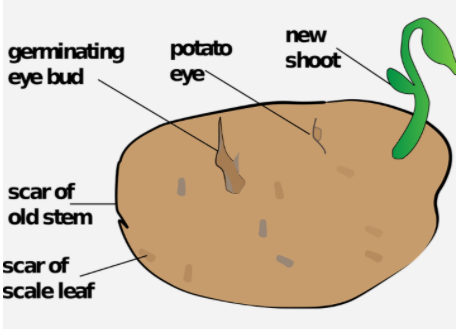Answer
393.6k+ views
Hint: Vegetative propagation also known as cloning is a technique that helps in the cultivation of only a high yielding variety of plants. It induces the plants to reach their maturation stage early. On the other hand, it also discourages evolution and leads to the accumulation of harmful mutations.
Complete answer:
Vegetative propagation is a type of asexual reproduction in which a fragment of the plant or any special reproductive structure can give rise to a new plant. The vegetative part in potato is known as the ‘node’ or ‘eye’ while in bryophyllum it is through ‘leaves’.
Vegetative propagation allows the production of exact copies or clones of the parent plant. It can occur naturally or artificially. In natural vegetative propagation, an axillary bud grows naturally into the lateral shoot and the base of the shoot gives rise to adventurous roots. Plants growing by natural vegetative propagation are-
-Rhizome- They are root-like stems growing horizontally beneath the soil. The nodes of the stem give rise to new roots and shoot (transforms into new plantlets). Example- iris, ginger, etc.
-Bulb- They grow as lateral buds from the parent plant body and give rise to new plants. Example- daffodil, etc.
-Tuber- It is the swollen, fleshy, underground part of the root. It gives rise to axillary buds from nodes or ‘eyes’ that grow into new plants. Example- the potato.
-Stolon- Stolon or Runner grows horizontally above the ground and touches the ground to give rise to new roots and shoot. Example- strawberry.
The methods of artificial vegetative propagation include-
-Cutting- It is the process of cutting a stem or bud from the parent plant which upon planting gives new root and stem. Example- garden geraniums, snake plants, etc.
-Grafting and Budding- It refers to ligating a cut piece of the stem (in Grafting) or a bud (in budding) to a mature plant stem having roots. Example- rose, avocado, etc.
Note: The application of vegetative propagation to produce new plants under sterile conditions in artificial media is known as Tissue culture. It is also known as Micropropagation. The nutrient media used here consists of hormones like auxin, cytokinin, and gibberellic acid; elements like potassium, calcium, sodium, magnesium; and carbohydrates. The hormones stimulate the growth of callus which finally develops into a new plant.

Eye bud in potato
Complete answer:
Vegetative propagation is a type of asexual reproduction in which a fragment of the plant or any special reproductive structure can give rise to a new plant. The vegetative part in potato is known as the ‘node’ or ‘eye’ while in bryophyllum it is through ‘leaves’.
Vegetative propagation allows the production of exact copies or clones of the parent plant. It can occur naturally or artificially. In natural vegetative propagation, an axillary bud grows naturally into the lateral shoot and the base of the shoot gives rise to adventurous roots. Plants growing by natural vegetative propagation are-
-Rhizome- They are root-like stems growing horizontally beneath the soil. The nodes of the stem give rise to new roots and shoot (transforms into new plantlets). Example- iris, ginger, etc.
-Bulb- They grow as lateral buds from the parent plant body and give rise to new plants. Example- daffodil, etc.
-Tuber- It is the swollen, fleshy, underground part of the root. It gives rise to axillary buds from nodes or ‘eyes’ that grow into new plants. Example- the potato.
-Stolon- Stolon or Runner grows horizontally above the ground and touches the ground to give rise to new roots and shoot. Example- strawberry.
The methods of artificial vegetative propagation include-
-Cutting- It is the process of cutting a stem or bud from the parent plant which upon planting gives new root and stem. Example- garden geraniums, snake plants, etc.
-Grafting and Budding- It refers to ligating a cut piece of the stem (in Grafting) or a bud (in budding) to a mature plant stem having roots. Example- rose, avocado, etc.
Note: The application of vegetative propagation to produce new plants under sterile conditions in artificial media is known as Tissue culture. It is also known as Micropropagation. The nutrient media used here consists of hormones like auxin, cytokinin, and gibberellic acid; elements like potassium, calcium, sodium, magnesium; and carbohydrates. The hormones stimulate the growth of callus which finally develops into a new plant.

Eye bud in potato
Recently Updated Pages
Basicity of sulphurous acid and sulphuric acid are

What is the stopping potential when the metal with class 12 physics JEE_Main

The momentum of a photon is 2 times 10 16gm cmsec Its class 12 physics JEE_Main

Using the following information to help you answer class 12 chemistry CBSE

Which of the following would not be a valid reason class 11 biology CBSE

Why should electric field lines never cross each other class 12 physics CBSE

Trending doubts
Difference between Prokaryotic cell and Eukaryotic class 11 biology CBSE

Fill the blanks with the suitable prepositions 1 The class 9 english CBSE

Two charges are placed at a certain distance apart class 12 physics CBSE

Difference Between Plant Cell and Animal Cell

What organs are located on the left side of your body class 11 biology CBSE

Change the following sentences into negative and interrogative class 10 english CBSE

The planet nearest to earth is A Mercury B Venus C class 6 social science CBSE

The Equation xxx + 2 is Satisfied when x is Equal to Class 10 Maths

What is BLO What is the full form of BLO class 8 social science CBSE



